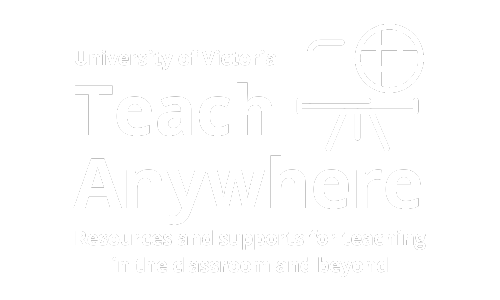Familiar teaching strategies might look a bit different in a multi-access classroom, but they have the same underpinning.
Lectures
In a multi-access classroom, you can deliver a lecture to both in-room and remote students, synchronously. You can also engage students through learning activities such as polls and Q&A. Here’s how it might look:
| In-room students | Synchronous remote students (Zoom) |
Instructor |
| Students listen and participate in the multi-access classroom. | Students listen and participate via videoconference | Instructor shows content on the displays or whiteboard, which feed to Zoom. |
Full Class Discussions
Instructors often lead discussions with the whole class between portions of a lecture, or before changing to another class activity. In the multi-access classrooms, the camera and mic feed from the room is shared through videoconference to allow the remote learners to see and hear the instructor and in-room students. Here’s how it might look:
| In-room students | Synchronous remote students (Zoom) |
Instructor |
| Students listen and participate in classroom. They can hear questions and comments from remote students. | Students listen and participate via videoconference (Zoom). The Zoom gallery can be displayed on an in-room monitor. | Instructor facilitates questions and answers across both modalities |
Small Group Discussions
Small group discussions allow for collaboration, and for students to share ideas and discuss course content in more personal ways. In multi-access classroom, you can also engage students participating both in-person and online (synchronous) in a small group discussion activities. Here’s how it might look:
| In-room students | Synchronous remote students (Zoom) |
Instructor |
| Students move chairs and desks to chat in groups in-person, share with the full class after | Students chat in break out rooms via videoconference, share with full class after (Zoom) | Instructor poses questions, moves students into groups, and facilitates sharing afterwards |
Guest Presentation
You might invite guest speakers to present in the multi-access classroom or from a remote location. Although you must be physically present in the multi-access classroom to manage the room, guests can present from a remote location, or from the classroom as the instructor would. Here’s how it might look:
| In person students | Synchronous online (Zoom) |
Guest Speaker | Instructor |
| Students listen and participate in classroom. | Students listen and participate via videoconference (Zoom)
|
Guest presenter presents either in person or via videoconference (Zoom)
|
Instructor facilitates session |
Demonstrations
You might want students to “gather around” to see a material object close-up. The multi-access classrooms have a demonstration table area, and with a push of a button, a camera feed gives all students an equally close-up look at what is happening. Here’s how it might look:
| In person students | Synchronous online (Zoom) |
Instructor |
| Students listen and participate in classroom. | Students see the objects via videoconference (Zoom) | Instructor at demo station |
